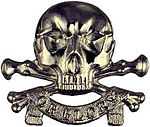17th/21st Lancers
| 17th/21st Lancers | |
|---|---|
 "Death or Glory" the Motto (cap badge) of the 17th/21st Lancers | |
| Active | 1922–1993 |
| Country | United Kingdom |
| Branch | British Army |
| Type | Cavalry of the Line/Royal Armoured Corps |
| Role | Light Cavalry |
| Size | 550 men |
| Nickname | The Death or Glory Boys |
| Motto | Death or Glory |
| March | The White Lancers |
The 17th/21st Lancers was a cavalry regiment of the British Army from 1922 to 1993.
It was formed in 1922 in England by the amalgamation of the 17th Lancers (Duke of Cambridge's Own) and the 21st Lancers (Empress of India's). From 1930 to 1939 it was deployed overseas; first in Egypt for two years, and then in India for seven. In 1938 the regiment was mechanised.
On the outbreak of war, the regiment immediately transferred back to the UK. When it arrived it had no equipment apart from rifles and revolvers. Although it was designated as a Heavy Armoured Regiment it never received the equipment; initial training was with a few Medium tanks and some lorries. It was designated as a Divisional Cavalry Regiment in 1940 but given machine guns and vehicles to make it a Motor Machine-Gun Regiment. In this form it was part of the 1st Motor Machine Gun Brigade (with the 16th/5th Lancers, 2nd Lothians and Border Horse) under 12 Corps defending south-east England. It then came under 26th Armoured Brigade in 6th Armoured Division later in the year. A group of personnel from the regiment were detached in December to form the cadre of the 24th Lancers.
In November 1942, the division was deployed to Tunisia after Operation Torch. Now equipped with Valentine Mk III and Crusader Mk III tanks, the regiment saw action for some time, including taking heavy losses defending Thala in the Battle of the Kasserine Pass in February 1943 during which all but twelve tanks were put out of action. After this the regiment was withdrawn, and refitted with M4A2 Sherman tanks. In April, an attempt to take the Fondouk Pass again put most of the regiment out of action.
The 6th Armoured Division deployed to Italy in March 1944, and fought to breach the Gustav Line. The regiment advanced to the Gothic Line, and spent the winter there—at points, serving as infantry rather than as an armoured unit, due to the static nature of the trench warfare there. After the final breakthrough in 1945, the regiment ended the war in Austria.
In 1946, the regiment was posted to Greece on internal security duties. In 1947 it deployed to the Suez Canal Zone and re-equipped as an armoured car regiment, and then to Palestine in 1948.
During the Cold War period, the regiment spent about half its time as an armoured unit in the British Army of the Rhine; it was also deployed to various overseas locations including Hong Kong. The regiment also undertook deployments to Northern Ireland, both as an armoured car unit and as dismounted infantry. In the mid-1980s, following a depot tour at the RAC Centre Bovington, some of the wives, badged and serving with the WRAC, were permitted to continue their service within the QMs Department in Germany.
In 1993, with the reductions in forces after the end of the Cold War, the regiment was amalgamated with the 16th/5th Lancers to form the Queen's Royal Lancers.
Alliances
 - Ceylon Mounted Rifles
- Ceylon Mounted Rifles
References
- "17th/21st Lancers". regiments.org. Archived from the original on 20 January 2008.
- History of the 17th/21st Lancers
| Preceded by 17th Lancers 21st Lancers |
17th/21st Lancers 1922–1993 |
Succeeded by Queen's Royal Lancers |